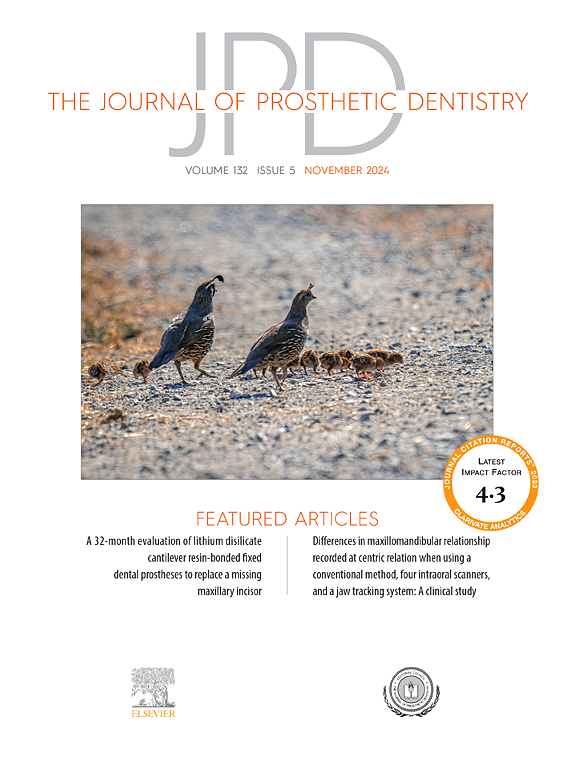Effect of geometric heterogeneity using an auxiliary device on the accuracy of complete arch implant scanning: An in vitro study of different clinical simulations
IF 4.8
2区 医学
Q1 DENTISTRY, ORAL SURGERY & MEDICINE
引用次数: 0
Abstract
Statement of problem
Intraoral scanning of implants supporting complete arch prostheses is limited because of the lack of geometric heterogeneity and unique reference points, creating inherent errors in the image stitching process by the scanner software program.
Purpose
The purpose of this in vitro study was to evaluate the significance of geometric heterogeneity on complete arch implant scanning by using a novel auxiliary geometric device. Three different clinical simulations were tested to assess its significance. The study also assessed whether scans produced using the auxiliary device would meet a clinically acceptable threshold.
Material and methods
A total of 60 scans (n=20) were performed using an intraoral scanner in 3 different clinical simulations: 2 parallel implants, 4 parallel implants, and 4 implants with a 30-degree posterior angulation of the distal implants. Scanning alternated between using the auxiliary geometric scanning device (test groups; 4IP+, 4IA+, 2IP+) and not using the device (control groups; 4IP-, 4IA-, 2IP-). A reference scan for each model was prepared from a high precision laboratory scanner. The scans were analyzed for accuracy in 3-dimensional deviation, interimplant distance deviation, and angular deviation by using an inspection software program. The effect of the auxiliary device was statistically analyzed by comparing scans of the same group using the paired t test for normally distributed data and the Wilcoxon Signed Rank test when data were not normally distributed (α=.05).
Results
Significant effects of the auxiliary geometric device were found in 3-dimensional, distance and angular deviations (P<.05). Scans performed using the device were significantly more accurate in most implant positions (P<.05). Linear and angular deviations were clinically acceptable for all test groups. However, the deviations were above the clinically acceptable threshold for the control groups.
Conclusions
Using an auxiliary geometric device significantly improved scanning accuracy and produced scans with clinically acceptable deviations, while standard digital scans exceeded the accepted clinical threshold.
使用辅助装置的几何异质性对全弓种植体扫描精度的影响:不同临床模拟的体外研究。
问题陈述:由于缺乏几何异质性和独特的参考点,支持全弓修复体的种植体的口腔内扫描受到限制,在扫描仪软件程序的图像拼接过程中产生固有的错误。目的:本体外研究的目的是评估几何异质性对使用一种新型辅助几何装置进行全弓种植体扫描的意义。三种不同的临床模拟测试来评估其意义。该研究还评估了使用辅助设备产生的扫描是否符合临床可接受的阈值。材料和方法:使用口腔内扫描仪在3种不同的临床模拟中进行了60次扫描(n=20): 2个平行种植体,4个平行种植体和4个远端种植体后侧30度角种植体。扫描之间交替使用辅助几何扫描装置(试验组;4IP+, 4IA+, 2IP+)和不使用设备(对照组;4ip -, 4ia -, 2ip -)。每个模型的参考扫描都是由高精度实验室扫描仪制备的。通过检查软件程序分析扫描的三维偏差、种植体间距离偏差和角度偏差的准确性。正态分布数据采用配对t检验,非正态分布数据采用Wilcoxon sign Rank检验,比较同一组扫描结果,对辅助装置的效果进行统计学分析(α= 0.05)。结果:辅助几何装置在三维、距离和角度偏差方面均有显著效果(p结论:使用辅助几何装置可显著提高扫描精度,产生临床可接受的扫描偏差,而标准数字扫描超过临床可接受的阈值。
本文章由计算机程序翻译,如有差异,请以英文原文为准。
求助全文
约1分钟内获得全文
求助全文
来源期刊

Journal of Prosthetic Dentistry
医学-牙科与口腔外科
CiteScore
7.00
自引率
13.00%
发文量
599
审稿时长
69 days
期刊介绍:
The Journal of Prosthetic Dentistry is the leading professional journal devoted exclusively to prosthetic and restorative dentistry. The Journal is the official publication for 24 leading U.S. international prosthodontic organizations. The monthly publication features timely, original peer-reviewed articles on the newest techniques, dental materials, and research findings. The Journal serves prosthodontists and dentists in advanced practice, and features color photos that illustrate many step-by-step procedures. The Journal of Prosthetic Dentistry is included in Index Medicus and CINAHL.
 求助内容:
求助内容: 应助结果提醒方式:
应助结果提醒方式:


